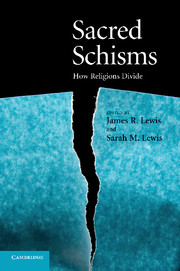Book contents
- Frontmatter
- Contents
- List of figures
- Notes on contributors
- Acknowledgments
- Introduction
- PART I THEORETICAL OVERVIEW
- PART II SURVEY OF SCHISMS IN SELECTED TRADITIONS
- PART III CHRISTIAN TRADITIONS
- PART IV WESTERN ESOTERIC TRADITIONS
- 8 Church Universal and Triumphant: shelter, succession and schism
- 9 Schism and consolidation: the case of the theosophical movement
- 10 Satanists and nuts: the role of schisms in modern Satanism
- 11 Schism as midwife: how conflict aided the birth of a contemporary Pagan community
- PART V NON-WESTERN/POSTCOLONIAL TRADITIONS
- Index
- References
9 - Schism and consolidation: the case of the theosophical movement
Published online by Cambridge University Press: 24 October 2009
- Frontmatter
- Contents
- List of figures
- Notes on contributors
- Acknowledgments
- Introduction
- PART I THEORETICAL OVERVIEW
- PART II SURVEY OF SCHISMS IN SELECTED TRADITIONS
- PART III CHRISTIAN TRADITIONS
- PART IV WESTERN ESOTERIC TRADITIONS
- 8 Church Universal and Triumphant: shelter, succession and schism
- 9 Schism and consolidation: the case of the theosophical movement
- 10 Satanists and nuts: the role of schisms in modern Satanism
- 11 Schism as midwife: how conflict aided the birth of a contemporary Pagan community
- PART V NON-WESTERN/POSTCOLONIAL TRADITIONS
- Index
- References
Summary
INTRODUCTION
Schism, the Encyclopedia of Religions informs us, “is the process by which a religious body divides to become two or more distinct, independent bodies. The division takes place because one or each of the bodies has come to see the other as deviant, as too different to be recognized as part of the same religious brotherhood.” (Ammerman 1987: 98). Schism is one of the major mechanisms producing religious diversity, and examples of the process are thus ubiquitous.
A religious schism will typically involve three successive phases. First, there is a period of tension between various individuals or factions within a group. There follows the actual break-up between these factions. Finally, a stage of consolidation allows the situation in the mother organization and the seceding body to stabilize. The last of these stages entails issues that the new organization will attempt to tackle. For years, members of a community have accepted to form part of an existing social formation, and have followed the rituals and doctrines as presented by the leading strata of that organization. When a break takes place, the leaders and most prominent members of the new group will need to create a distinct identity for the new community.
Identity politics of this kind involves characteristic dilemmas. Consider one of the most frequent mechanisms involved in doctrinal and ritual innovation. Claude Lévi-Strauss coined the nearly untranslatable term bricolage to describe how mythical innovations take place.
- Type
- Chapter
- Information
- Sacred SchismsHow Religions Divide, pp. 196 - 217Publisher: Cambridge University PressPrint publication year: 2009



